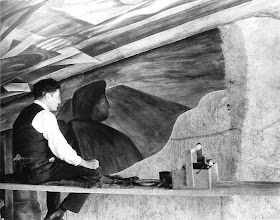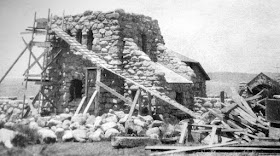(Click on images to enlarge)
I recently ran across the above 1926 Diego Rivera drawing of a back which immediately brought to mind Edward Weston's 1925 images of the backs of Anita Brenner and his son Neil and the 1927 posterior images of his then lovers Christel Gang and Bertha Wardell. Below is more or less a chronological depiction of the cross-pollination going on between Weston and close friends Jean Charlot, Diego Rivera and possibly others on this particular theme.
Anita Brenner, 1925. Edward Weston. Collection Center for Creative Photography. ©1981 Arizona Board of Regents. From Avant-Garde Art and Artists in Mexico: Anita Brenner's Journals of the Roaring Twenties edited by Susannah Joel Glusker, University of Texas Press, 2010, Vol. 1. Edward Weston photo. ©1981Center for Creative Photography. Arizona
Board of Regents.
Edward Weston's abstract nude back photos of the mid-1920s were a natural outgrowth of his 1910s nudes of his wife Flora, lover Margrethe Mather and various dancers and other lovers. His 1925 Anita Brenner images may have been inspired by Man Ray's below photo depicting the transformation of the female body into a musical instrument. Ray painted the f-holes
of a stringed instrument onto the photographic print and then rephotographed the print, altering what was originally a classical nude. The armless torso seemingly fascinated Weston as this theme appeared again and again in his nudes over the years.
"Ingre's Violin," model, Kiki of Montparnesse. Man Ray, 1924.
Weston's awareness of Man Ray's "trickery" is evidenced by a 1924 Daybooks entry comparing a manipulated photo of Tina's to Man Ray's recent work.
"Tina printed her most interesting abstraction done in the tower of Tepotzotlan (see below). She is very happy over it and well she may be. I, myself would be pleased to have done it. She printed from the enlarged positive, so she has a negative print and shows it upside down. All of which sounds "fakey," and, in truth, may not be the best usage of photography, but it really is very genuine and one feels no striving, no sweat as in the Man Ray experiments." (Daybooks, Vol. 1, Mexico, May 2, 1924, p. 69). (Author's note: The above Man Ray image was first published in June 1924 thus would not have been known to Weston at the time of this entry but could well have been known to him by the time of his 1925 Brenner sitting(s)).
Interior of Church Tower, Tepotzotlan, Mexico, 1924. Tina Modotti. From ArtNet.
Tina and Edward were first introduced into the Mexico City art scene through a March 1922 exhibition arranged by Ricardo Gomez Robelo to entice Edward, Tina and her husband Robo de Richey to join him after he returned from his Los Angles exile to a burgeoning post-revolutionary Mexico City arts climate. Having accepted a high level position in the Art Department of Jose Vasconcelos's Ministry of Public Education, Robelo (see top center below) had been a Tina-infatuated member of their social circle during his 1919-21 period in L.A..
De Cordova, Vera, "Los Fotografias como Verdadero Arte," El Universal Ilustrado (México, D. F., Mexico), No. 255 (Mar. 23, 1922), pp. 30-31, 55. From Digital Archive, Museum of Fine Arts, Houston.
The exhibition featured Weston, Margrethe Mather and Jane Reece photos of Tina, Robo, Robelo and mutual friends and drawings and batiks by Robo (see above review). Having preceded Edward and Tina to Mexico where he opened a studio in Robeleo's lodgings, Robo suffered an untimely February 9, 1922 death while Tina was on her way to join him. While settling Robo's affairs Tina helped Robelo stage the promised exhibition as he introduced her to his circle (and Robo's by association) of friends such as Diego Rivera and his assistants Jean Charlot and Xavier Guerrero, and Adolfo Best Maguard, Roberto Turnbull and numerous others. Tina would would reconnect with, and introduce Weston and their mutual friends to Guerrero, Turnbull and Best-Maguard when they shepherded an exhibition of Mexican arts and crafts to Los Angeles in the fall of 1922. (For much more on this see my "The Schindlers and the Hollywood Art Association.").
Anita Brenner, 1925. Edward Weston. Avant-Garde Art & Artists in Mexico: Anita Brenner's Journals of the Roaring Twenties edited by Susannah Joel Glusker, University of Texas Press, 2010.
Tina and Edward moved to Mexico in August 1923 and largely through Tina's 1922 connections they were quickly accepted into the avant-garde art scene. I highly recommend reading The Daybooks of Edward Weston, Volume 1, Mexico and Avant-Garde Art & Artists in Mexico: Anita Brenner's Journals of the Roaring Twenties for fascinating personal accounts of Tina and Edward's and their mutual friends' activities in Mexico between 1923 and 1929.
From Avant-Garde Art and Artists in Mexico: Anita Brenner's Journals of the Roaring Twenties edited by Susannah Joel Glusker, University of Texas Press, 2010, Vol. 1, p. 52. Collection Center for Creative Photography. ©1981 Arizona Board of Regents.
Idols Behind Altars by Annita Brenner, Harcourt, Brace and Co., New York, 1929. Cover illustration by Jean Charlot. Photo illustrations by Edward Weston and Tina Modotti. (From my collection).
Idols Behind Altars by Annita Brenner, Harcourt, Brace and Co., New York, 1929. Frontispiece "Hand of the Potter Amado Galvan" by Edward Weston.
Weston captured numerous abstract variants of Anita Brenner's back sometime in 1925. Sharing these among their mutual circle of friends most likely inspired similar work from Weston's by then close friends Jean Charlot and Diego Rivera and possibly others. This work can be seen more or less chronologically below. Tina and Edward's close friendship with Brenner resulted in a lucrative 1926 commission to provide the illustrations for Brenner's seminal Idols Behind Altars which was published in 1929 (see above). The hundreds of Weston-Modotti images compiled for Idols Behind Altars served as Sergei Eisenstein's inspiration for "Que Viva Mexico!" filmed in 1931. (For much more on this see my "Brett Weston's Smokestacks, 1927").
Eisenstein issue, "Que Viva Mexico!" Experimental Cinema."
Anita Brener, 1925. Edward Weston photo. Collection Center for Creative Photography. ©1981 Arizona Board of Regents.
From Avant-Garde Art and Artists in Mexico: Anita Brenner's Journals of the Roaring Twenties edited by Susannah Joel Glusker, University of Texas Press, 2010, Vol. 1, p. 52. Collection Center for Creative Photography. ©1981 Arizona Board of Regents.
Diego Rivera, 1924. Edward Weston photo. Collection Center for Creative Photography. ©1981 Arizona Board of Regents.
Tina Modotti, 1924. Edward Weston photo. Collection Center for Creative Photography. ©1981 Arizona Board of Regents.
Nude, 1925 by Jean Charlot. Model Luz Jimenez. From Avant-Garde Art and Artists in Mexico: Anita Brenner's Journals of the Roaring Twenties edited by Susannah Joel Glusker, University of Texas Press, 2010, Vol. 1.
Jean Charlot, 1924 by Tina Modotti. From the Red List.
Model Luz Jimenez with her child, 1926 by Tina Modotti. From Wikipedia.
Model Luz Jimenez clothed, 1926 by Edward Weston. From Avant-Garde Art and Artists in Mexico: Anita Brenner's Journals of the Roaring Twenties edited by Susannah Joel Glusker, University of Texas Press, 2010, Vol. 1. Collection Center for Creative Photography. ©1981 Arizona Board of Regents.
Upon his 1926 return to Mexico with son Brett, Weston posed Anita Brenner's erstwhile domestic and cook (and Rivera's and Charlot's long time model) Luz Jimenez on a petate, this time capturing her back fully clothed in colorful Mexican garb. (For much background on Luz see Avant-Garde Art and Artists in Mexico: Anita Brenner's Journals of the Roaring Twenties and Dreaming With His Eyes Open: A Life of Diego Rivera by Patrick Marnham, Knopf, New York, 2000, pp. 303-4).
Diego Rivera, 1925. Model likely Luz Jimenez.
"The Flower Seller," 1926 by Diego Rivera. Model Luz Jimenez.
Luz Jimenez was featured clothed and veiled by a basket of flowers in Rivera's stunning 1926 piece "The Flower Seller."
"Nude With Calla Lillies," 1944 by Diego Rivera. Model Frida Kahlo.
Nude backs and calla lillies became recurring themes in Rivera's ouevre over the years evidenced by the above work from 1944.
Neil Weston, 1925. Collection Center for Creative Photography. ©1981 Arizona Board of Regents.
In his 1925 interlude back in the U.S., Weston continued his nude back experiments with son Neil. He also made some exquisite nudes of then lover Miriam Lerner (see below), a close friend of earlier Weston muses Betty Katz and Margrethe Mather. Both Katz and Lerner would later become clients (and lovers?) of mutual Weston friend architect R. M. Schindler.
Nude (Miriam Lerner, 1925 by Edward Weston. Collection Center for Creative Photography. ©1981 Arizona Board of Regents.
"Germination," 1926, by Diego Rivera. Tina Modotti, model. From Addoway.
Diego Rivera, 1926. From Pinterest.
Snapshot of Anita Brenner posing, 1926. Photo by Manuel Heilblum. From Avant-Garde Art and Artists in Mexico: Anita Brenner's Journals of the Roaring Twenties edited by Susannah Joel Glusker, University of Texas Press, 2010, Vol. 1, p. 52.
Christel Gang, 1927. Edward Weston photograph. Collection Center for Creative Photography. ©1981 Arizona Board of Regents.
Christel Gang, 1927. Edward Weston photo. Collection Center for Creative Photography. ©1981 Arizona Board of Regents.
Weston spent his first year back from Mexico juggling numerous lovers including Christel Gang and Bertha Wardell (see above and below).
Bertha Wardell, 1927. Edward Weston
photograph. Collection Center for Creative Photography. ©1981 Arizona
Board of Regents.
For much more on the related abstract nudes of dancer Bertha Wardell see my "Bertha Wardell Dances in Silence: Kings Road, Olive Hill and Carmel."
Orozco, 1926 by Edward Weston. From Avant-Garde Art and Artists in Mexico: Anita Brenner's Journals of the Roaring Twenties edited by Susannah Joel Glusker, University of Texas Press, 2010, Vol. 1.
The above and below "rear views" of Orozco and Rivera depicted while working on their murals are a nice example of art imitating art. Again Weston may have provided the inspiration for Rivera with his 1926 image of Orozco at work. (Author's note: For much on Orozco's friendship with Edward and Brett Weston and his 1930 "Prometheus" mural at Pomona College see my "Richard Neutra and the California Art Club.").
Diego Rivera, detail from Making a Fresco, 1931. Photo by Michael Nye. From Avant-Garde Art and Artists in Mexico: Anita Brenner's Journals of the Roaring Twenties edited by Susannah Joel Glusker, University of Texas Press, 2010, Vol. 1, p. 359.
From the selected research for this piece it appears that an entire exhibition could be woven around this fascinating topic. It would be a great theme for the upcoming Getty initiative, Pacific Standard Time: L.A./L.A.. I will be adding material to this post as I discover additional material so check back periodically.











































.jpg)




